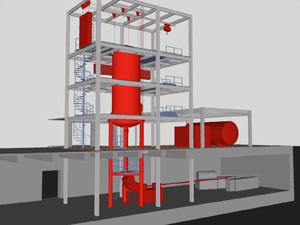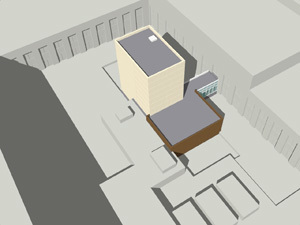
The University of Notre Dame has begun installation of a new nuclear accelerator in its Nuclear Science Laboratory (NSL), located in the Nieuwland Hall of Science. A huge crane has been set up to facilitate the transport for the accelerator unit to its final position in the center of the NSL research facilities. Construction will continue on this project for the next few months.
The new National Science Foundation (NSF)-funded 5 MV accelerator represents a major equipment upgrade for the University and is the first accelerator NSF has funded in nuclear physics in nearly a quarter century.
The new vertical accelerator will be housed inside a new 40-foot-tall tower located above the existing NSL in the center of Nieuwland. This location and the weight of the accelerator tank (nearly 20,000 pounds) require the use of a large crane visible from most parts of the campus. The structural steel frame for the tower will be installed during early October followed by the accelerator tank and then the concrete walls. Building construction will be complete by the end of 2011.
The accelerator will replace the KN accelerator and provide high intensity heavy ion beams for experiments at Notre Dame’s St. George recoil separator and will also increase the intensities for protons and alpha beams. The accelerator will be primarily used to expand the research program of Notre Dame’s Institute for Structure and Nuclear Astrophysics (ISNAP) and the Joint Institute for Nuclear Astrophysics (JINA), a Physics Frontier Center of NSF.
ISNAP is a university research center that operates the NSL at Notre Dame. The laboratory is built around three Van de Graff accelerators operating in different energy regimes and has a broad program in low energy physics. These three accelerators offer ideal conditions for experiments exploring basic nuclear physics questions about the quantum structure of nuclei or the origin of the elements in nuclear reaction processes in stars.
The NSL accelerators have the capability of producing intense particle beams of both stable and unstable nuclei of various types for research interests including nuclear reactions with radioactive ion beams (RIBS) and nuclear astrophysics associated with stellar explosions. The laboratory has a large number of national and international user groups, including US National Laboratories, who work with the local research groups.

In addition to its basic science interests, ISNAP researchers have developed a number of interdisciplinary applications of nuclear physics techniques primarily in materials analysis and radiation chemistry. In collaboration with faculty from Notre Dame’s Department of Anthropology, PIXE (Particle Induced X-ray Emission) is used to test the provenance and age of archaeological samples. Environmental studies are being pursued through accelerator mass spectrometry and radioactive counting techniques. The laboratory also pursues research with the medical industry such as the testing of new detectors as well as performing studies of artificial joint components to measure durability.
The laboratory’s radiation chemistry program revolves around studies of the effect of ionizing radiation on the molecular decomposition of water and various organic materials, including polymers. The practical aspect to this type of work has direct applications to the management of nuclear reactors and the treatment of storage of radioactive waste. The effect of low energy radiation on biological cell and DNA material is also of great interest for radiation treatment applications. This work is carried out by the Notre Dame Radiation Laboratory which is funded by the U.S. Department of Energy.
Notre Dame also is the home of JINA, which is one of the world’s leading research institutions in experimental and theoretical nuclear astrophysics using the NSL as one of its core research laboratories.
JINA is operated as a collaboration between Notre Dame, Michigan State University and the University of Chicago but has a large number of associated institutions on the North and South American continents, in Europe, Asia and Australia. JINA is funded to foster an interdisciplinary approach to nuclear astrophysics that seeks to coordinate efforts between the astrophysics and nuclear physics communities, as well as those between experimentalists, theorists and observers.
The overall scientific goal of JINA is to study the broad range of nuclear processes in our universe that control stellar evolution, trigger supernova events, and lead to thermonuclear explosions observed as novae, x-ray and ỵ-ray bursts. Michael Wiescher, a Notre Dame nuclear astrophysicist and winner of the prestigious Bethe Prize of the American Physical Society, serves as JINA’s director.
The new accelerator at Notre Dame will help to recreate stellar nuclear processes in the laboratory to complement the observational studies of new earth- and space-based telescopes that trace past and present nucleosynthesis processes in the Cosmos.
Contact: Michael Wiescher, 574-631-6788, michael.c.wiescher.1@nd.edu